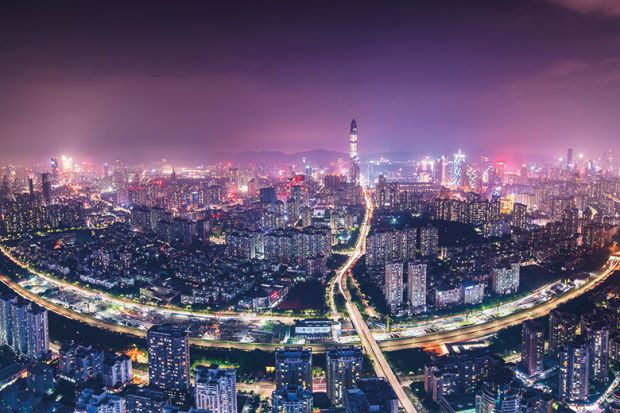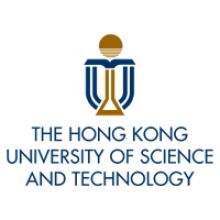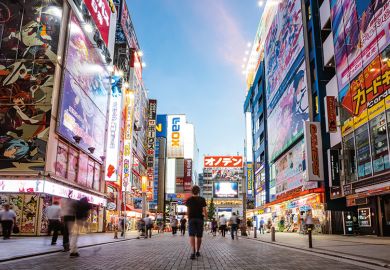Browse the full Asia University Rankings 2018 results
Shenzhen was a small fishing village about 40 years ago. Today, it has been transformed into a megacity, hosting more than 30,000 technology companies, 17 of which have more than Rmb10 billion (£1.13 billion) in sales.
In terms of connectivity, Shenzhen had roughly 12.2 million visitors in 2015, it was the world’s third-largest container port that same year, and it accounted for $377 billion (£283 billion) worth of foreign trade in 2016.
All that activity is in line with the country’s “harmonious society” philosophy, which is also seen in China’s Belt and Road initiative to increase international connectivity.
Since its opening-up to the world in 1978, China has grown to be the world’s second-largest economy and has increased its engagement and influence in regional and global affairs, developing significant connections between regions, countries and cities.
Shenzhen served as China’s first Special Economic Zone to implement the country’s open-door policy and modernisation strategy.
Feature: could SUSTech emulate Stanford and eclipse Hong Kong?
Being located in Shenzhen – considered to be China’s Silicon Valley – the Southern University of Science and Technology (SUSTech) plays a role in increasing international connectivity and fostering collaborative endeavours within academia and beyond to address the grand challenges in our contemporary world.
In fact, SUSTech’s goals are to be a world-class global research university, to cultivate outstanding and innovative talents, and to produce high-impact research. The university also aims to support the sustainable development of Shenzhen, Guangdong province and China more widely by advancing knowledge and promoting the application of new technologies.
SUSTech was established just seven years ago to serve as a model for higher education reform in the interest of modernising the national university system.
It is anchored in research, innovation and entrepreneurship, the key attributes vital for socio-economic development in our interconnected cities, regions and countries.
As a reformative and global university, SUSTech is known for several innovations in China, among them a modern governance system, an advanced, comprehensive admissions system, English as the language of instruction, and a curriculum rooted in innovation and entrepreneurship.
These measures ensure institutional autonomy and merit-based admission and also inculcate a culture of innovation and entrepreneurship in our students and graduates, which equips them for the increasingly challenging realities of the world.

Search our database for the latest university jobs in Asia
We also take pride in the quality of our faculty: not only do all our academics hold PhDs, 60 per cent of which come from top global research universities, but 30 per cent of our scholars were recruited via national initiatives, namely the Thousand Talents Programme and the Thousand Young Talents Programme, which were established in 2008 to attract leading scholars from across the world to China.
SUSTech’s youth has been no barrier to its forming a string of partnerships with various universities within and outside East Asia, including the University of Hong Kong, the Hong Kong University of Science and Technology, the National University of Singapore, Seoul National University, the University of Queensland, Johns Hopkins University, Columbia University, the University of British Columbia, King’s College London, the University of Birmingham and the University of Warwick, to name but a few.
Together, we aim to leverage our partnerships to increase connectivity between our universities and cities, through research, innovation and entrepreneurship, and to nurture our students and increase their capacities to contribute to solving the challenges confronting our rapidly changing world.
Over the past seven years of working together, Shenzhen and SUSTech have formed a symbiotic relationship. The city has provided resources, land and funding to the university, aiding our development as we implement our plans for the future, and has taken a guiding hand in our evolution. In return, talent, innovation and culture flow from the university into the city: talent, as more than 90 per cent of SUSTech graduates who go straight into work remain in the region after graduating; innovation, as many of those graduates are employed at companies such as Tencent and Huawei, two of China’s most prominent tech companies, both of which are headquartered in the city; and culture, as the influx of young, dynamic and aspirational graduates seek to express their creativity and launch their innovations.
This relationship has become increasingly intertwined. Together, Shenzhen and SUSTech have jointly established the China-UK Joint Artificial Intelligence Research Institute (in collaboration with the University of Birmingham) and the SUSTech-HKU Joint Lab within different districts of the city (in partnership with the University of Hong Kong), providing physical testaments to our cooperation.
When we talk about connecting cities and changing the world, we realise that cities are in essence just collections of people – and it is people who facilitate connectivity as they mix and mingle with other people, collaborating across neighbourhoods, cities, provinces and countries.
Download a copy of the Asia University Rankings 2018 digital supplement
Universities, their stakeholders and leaders, their faculties and student bodies, carry a significant responsibility in shaping and preparing the citizens of our respective cities and countries.
Research, innovation and entrepreneurship not only facilitate sustainable economic development, they also increase the possibility of interconnectivity between our cities and countries.
Advancing international collaboration between universities through student and faculty exchanges, joint research efforts, conferences and summits can provide platforms for increased sociocultural awareness and understanding.
Furthermore, inter-university and international collaboration in various research, innovation and entrepreneurship undertakings builds bridges that promote sustained friendship, increased cooperation and intercultural understanding that provide the foundation necessary for us to move towards our common goal of a sustainable, peaceful and progressive world.
The 2018 Times Higher Education Asia Universities Summit, co-hosted by SUSTech this week and the first THE summit to be held in mainland China, was a platform not only to exchange intellectual views, but also to reconnect with old friends and to make new ones, to establish new connections, and to expand collaborations between our respective universities.
In line with the summit’s theme, “connecting cities, changing the world”, together we can support each other’s endeavours, missions and goals, and contribute to changing our world for the better.
Shiyi Chen, president, Southern University of Science and Technology.
Watch our video of the 2018 results
POSTSCRIPT:
Print headline: Weaving a better world
Register to continue
Why register?
- Registration is free and only takes a moment
- Once registered, you can read 3 articles a month
- Sign up for our newsletter
Subscribe
Or subscribe for unlimited access to:
- Unlimited access to news, views, insights & reviews
- Digital editions
- Digital access to THE’s university and college rankings analysis
Already registered or a current subscriber? Login










